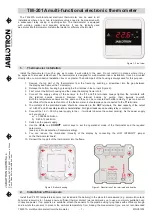
1. Remove
1
⁄
4
" of wire insulation
from the wire ends. Ensure the
bare wires are clean and free
of corrosion.
2. Route the wires to the terminal
blocks and place the end of
the wires in the correct
wiring locations.
Note:
The heat terminals (Rh
and W) are not polarity sensitive.
Mounting the Thermostat
to the Wall Plate
To mount the thermostat to
the wall plate, refer to the
following instructions.
1. Place the tabs at the bottom
of the front enclosure into
the grooves at the back of
the wall plate.
2. Check the alignment between
the two components.
3. Apply pressure to the top of
the thermostat until it snaps
into place.
Operation
The dynamics of a radiant
heating system differ from a
typical baseboard or forced-air
heating system. This is because
radiant systems heat the mass
and the objects in the room. The
Uponor thermostat uses optimized
control logic to control radiant
systems. Refer to the following
information for the different
modes of operation.
Mounting the Wall Plate
The thermostat case can mount to a
standard electrical wall box or most
wall surfaces using suitable
hardware. To properly mount the
wall plate, refer to the following
instructions.
1. Separate the front and back
plates of the thermostat by
gently applying downward
pressure on the front plate to
separate the front plate from
the back plate.
2. Pull the thermostat wire
through the round opening in
the back plate.
3. Place the back plate against the
wall at the desired location to
cover the opening or electrical
wall box.
4. Align the holes of the back
plate to the holes in the wall or
electrical wall box, and attach
the plate with screws. If
mounting the plate to drywall,
use wall anchors and screws.
5. If the wall cavity behind the
thermostat is susceptible to
drafts (e.g., from a return-air
plenum or an uninsulated wall),
plug and seal any openings to
prevent them from affecting
temperature readings.
Wiring the Thermostat
To properly wire the thermostat,
refer to the following instructions.
Note:
All wiring must comply with
local electrical codes and standards.
Caution:
Disconnect electrical
power to the system to prevent
electrical shock and damage.
Heating Mode
When the room temperature falls
0.5°F (0.25°C) below the desired
room setting, the control devices wired
to the thermostat activate. When the
room temperature rises 0.5°F (0.25°C)
above the desired room setting, the
control devices wired to the thermostat
deactivate.
Cooling Mode
When the room temperature rises to
1°F (0.5°C) above the desired room
setting, the control devices wired to
the thermostat activate. When the
room temperature falls 1°F (0.5°C)
below the desired room setting, the
control devices wired to the thermostat
deactivate.
Automatic Mode
The thermostat automatically switches
between heating and cooling modes
based on the heating and cooling
setpoints. (The cooling setpoint must
be greater than or equal to the heating
setpoint.) When the thermostat is in
automatic mode, the cooling mode
icon (snowflake) flashes when the
cooling system is active; the heating
mode icon (floor with tubing) flashes
when the heating system is active.
Pulse Width Modulation
(PWM) Mode
When the room temperature is
between 1 to 3°F (0.5 to 1.5°C) below
the desired room setting, the
thermostat manages the application of
heat by varying the on-and-off cycles,
or what is known as pulse width
modulation (PWM). The on-and-off
times vary depending on the difference
between room and desired
temperatures — the further away, the
greater the on time. This prevents the
room temperature from rising above
the desired temperature. The heating
system will run continuously at
temperature differences greater than
3°F (1.5°C).
Push top
down to
separate
2
18 AWG,
2 Cond. Stranded
2.72"
(69mm)
5.00"
(127mm)
0.75"
(19mm)
2.5"
(63.5mm)
























